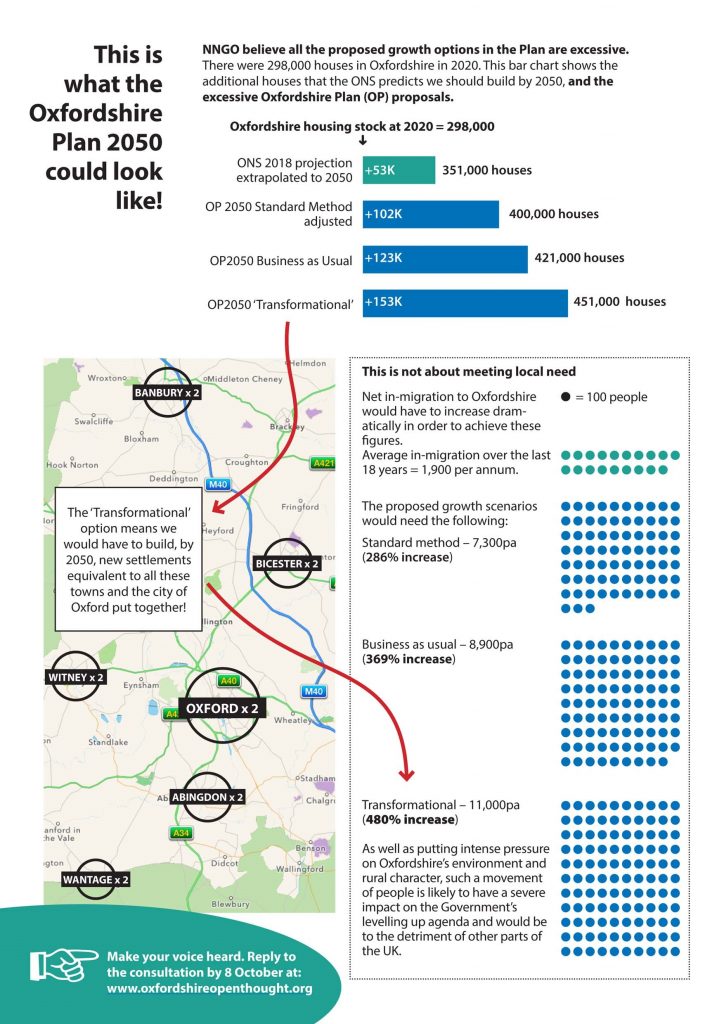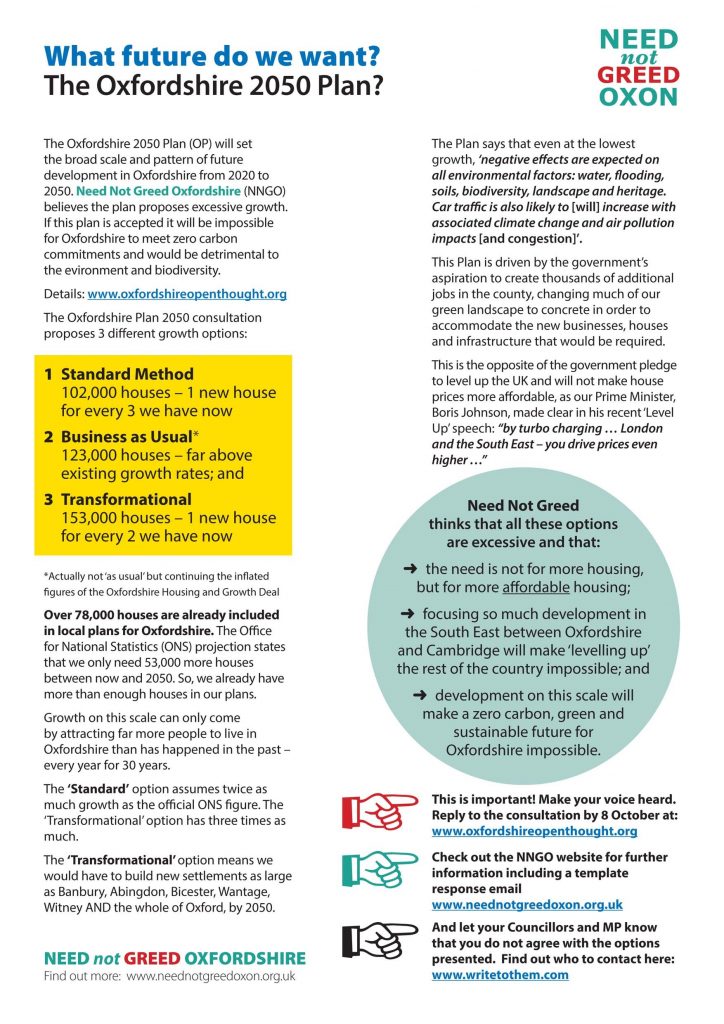Alternative Ox-Cam Arc spatial framework consultation reveals that more than 9 out of 10 people would vote ‘No’ to the Ox-Cam Arc
Stop The Arc Group (STARC) created an alternative Arc Spatial Framework consultation with the Oxford POETS (Planning Oxfordshire’s Environment and Transport Sustainably) and with help and advice from a number of other concerned groups across the Arc. The consultation highlighted some of the hard choices that lie ahead – for example between development and the environment – and asked people how rapidly the Arc should grow.
Responders were not against growth, but wanted it limited to the average or below-average rate expected for the rest of country – a fair share, not a disproportionate share.
The results and comments show that the public is fed up with being kept in the dark about all Ox-Cam Arc plans. The official Government consultation document contained not a single word on the levels of growth in jobs, houses and economic output that this Whitehall-driven Arc plan involves. Nothing at all. Why is this? What is the Government afraid of?
Read more, including key findings, on the STARC website.
The alternative consultation remains open. If you would like to add your views please do so here.
Confused Methodology needs Independent Review
Need Not Greed Oxfordshire is calling on councillors to do a ‘Kickflip Indy’ on the Oxfordshire Plan, and change direction to a lower rate of growth, to stay firmly on top of the environmental skateboard.
The campaigners say that even the lowest rate of growth proposed in the Plan (102,000 houses by 2050) would require such a dramatic increase in housing and population that a zero-carbon, sustainable future for Oxfordshire would be virtually impossible.
In particular, they have criticised the Oxfordshire Growth Needs Assessment (OGNA), a background paper which is supposed to provide the ‘robust and transparent’ evidence to support the various growth options.
David Young, from Greenway (an NNGO coalition member), said: “This document is complicated and obscure. We suspect that most councillors won’t have time to read it, let alone understand it. Far from being robust and transparent, it seems to exaggerate the figures at every turn and then hide the impacts.
“We believe that to use the Oxfordshire Growth Needs Assessment as the basis for planning for the county for the next 30 years would be entirely inappropriate. We think the only solution now is an independent peer-review of this document which is not fit for purpose.
“We are calling on the councillors and officers involved in the Oxfordshire Plan 2050 team to act quickly to put such a review in place.”
The public consultation on the Oxfordshire Plan 2050 ends on 8 October. NNGO is urging all Oxfordshire residents to have their say.
What future do we want? The Oxfordshire Plan 2050?


The Oxfordshire Plan will set the development framework for the county for the next generation. It will affect all Oxfordshire residents.
Take a look at the NNGO flyer above or download here and read our concerns about the Oxfordshire Plan 2050.
Want to have your say in the future of Oxfordshire?
Here’s a template email which you can cut and paste, feel free to change it to make it your own and to cover your specific concerns eg Green Belt, infrastructure, water quality.
SEND TO: info@oxfordshireplan.org
DEADLINE: 8 October
If you have a further minute, please share your email with your Councillors and MP and let them know that you do not agree with the options presented in the Oxfordshire 2050 Plan. You can find out who to contact here: www.writetothem.com
Dear Oxfordshire 2050 Team,
Preferred Policy Option 28 on Homes states: ‘Through this consultation on the Regulation 18 Part 2 stage of the Oxfordshire Plan, the scenarios for the total housing requirement figure 2020-2050 (the OGNA) need to be considered and views are sought’. My views are as follows:
I would like to see the total housing requirement set at the lowest possible figure, preferably lower than the Option 1 Standard Method, which is still substantially above that needed to cater for the existing population.
I am deeply concerned at the current and proposed levels of development in Oxfordshire and the plans to supercharge the growth of the county as traditionally measured. This will result in many more people moving into the area requiring ever more houses, roads and traffic. This scale and pace of development, replacing countryside with concrete, is completely inconsistent with our declared climate and nature emergencies.
The housing growth option in the 2050 Plan described as ‘business as usual’ is actually continuing an exceptionally high growth plan which is set to transform much of our landscape over the coming years and will enable house builders and land owners to profit at the expense of the quality of life of existing residents.
There should be an option for Oxfordshire to grow organically, based on up to date natural population growth numbers produced by the Office for National Statistics, with the focus on making housing in the area more affordable. Policies on restricting buy to let and introducing a land value uplift tax would be good. Policies enabling housing association and council houses on brownfield sites would also be enormously helpful.
I also want our Council Leaders to resist any attempts by central Government to impose an increase on the number of houses to be built in Oxfordshire as part of the OxCam Arc proposals.
Local and by-election results over the last couple of years suggest that a great many members of the public share these concerns and I would ask that you and our elected representatives robustly engage government to rethink its strategy for Oxfordshire and focus instead on their election promise of levelling up the UK – creating jobs where people already live.
[Add name & address]
The Ox-Cam Arc Regional Coalition Launches an Alternative Consultation
In late July the Government launched the first of three consultations on its Ox-Cam Spatial Framework plans. A number of campaigning groups were concerned that the official consultation fails to address the difficult choices ahead. They have produced an alternative 5-minute questionnaire that allows people to more freely express their opinions on the level of development that is being suggested for the Arc and to choose between what are often conflicting aims of the official plans.
The alternative consultation can be found here.
The results will be published in early October.